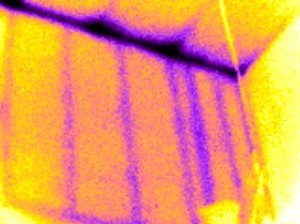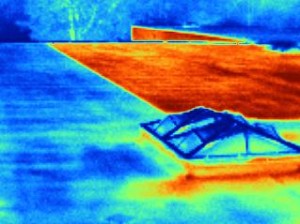Building Sciences / Building Envelope
 The primary diagnostic procedure for determining the thermal performance of a building envelope is infrared thermography. It can be used to identify heating and cooling loss due to poor construction, missing or inadequate insulation and moisture intrusion. Correcting the defects plays a significant role in increasing building efficiency and structural integrity.
The primary diagnostic procedure for determining the thermal performance of a building envelope is infrared thermography. It can be used to identify heating and cooling loss due to poor construction, missing or inadequate insulation and moisture intrusion. Correcting the defects plays a significant role in increasing building efficiency and structural integrity.
Thermography can identify surface temperature variations of the building envelope, which relates to problems in the structure, thermal bridging, moisture content and air leakage. Two primary mechanisms for heat loss in buildings are conduction through the walls and air leakage. Both can be identified from the surface of the building with infrared thermography. Early correction of the faults identified can be made before extensive damage occurs.
Conductive Losses
 Problems identified as conductive losses are: missing insulation, improperly installed or compressed insulation, shrinkage or settling of various insulating materials; excessive thermal bridging in joints between walls and the top and bottom plates; moisture damage to insulation and building materials; heat loss through multi-pane windows with a broken seal; leaks in water pipes; damaged heat ducts; location of, or leakage in buried steam lines, water lines or underground sprinkler systems, etc.
Problems identified as conductive losses are: missing insulation, improperly installed or compressed insulation, shrinkage or settling of various insulating materials; excessive thermal bridging in joints between walls and the top and bottom plates; moisture damage to insulation and building materials; heat loss through multi-pane windows with a broken seal; leaks in water pipes; damaged heat ducts; location of, or leakage in buried steam lines, water lines or underground sprinkler systems, etc.Air Leakage
In addition to energy loss caused by excessive air leakage, it can cause condensation to form within and on walls. This can create many problems; reduce insulation R-value, permanently damage insulation, and seriously degrade materials. It can rot wood, corrode metals, stain brick or concrete surfaces, and in extreme cases cause concrete to spall, bricks to separate, mortar to crumble and sections of a wall to fall jeopardizing the safety of occupants. It can corrode structural steel, re-bar, and metal hangars and bolts with very serious safety and maintenance issues. Moisture accumulation in building materials can lead to the formation of mold that may require extensive remediation.
Virtually anywhere in the building envelope where there is a joint, junction or opening, there is potential for air leakage. With the use of the IR-InSight or FlexCam S infrared imagers, one can identify thermal irregularities on the building envelope and the thermal pattern discerning whether the pattern indicates a problem with the insulation, air leakage or the building structure.
